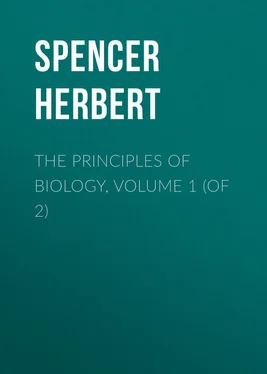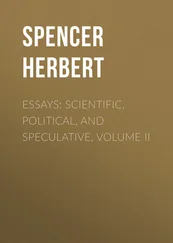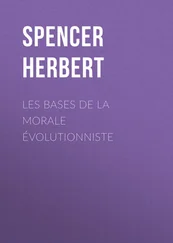Herbert Spencer - The Principles of Biology, Volume 1 (of 2)
Здесь есть возможность читать онлайн «Herbert Spencer - The Principles of Biology, Volume 1 (of 2)» — ознакомительный отрывок электронной книги совершенно бесплатно, а после прочтения отрывка купить полную версию. В некоторых случаях можно слушать аудио, скачать через торрент в формате fb2 и присутствует краткое содержание. Жанр: Философия, foreign_antique, foreign_prose, на английском языке. Описание произведения, (предисловие) а так же отзывы посетителей доступны на портале библиотеки ЛибКат.
- Название:The Principles of Biology, Volume 1 (of 2)
- Автор:
- Жанр:
- Год:неизвестен
- ISBN:нет данных
- Рейтинг книги:3 / 5. Голосов: 1
-
Избранное:Добавить в избранное
- Отзывы:
-
Ваша оценка:
- 60
- 1
- 2
- 3
- 4
- 5
The Principles of Biology, Volume 1 (of 2): краткое содержание, описание и аннотация
Предлагаем к чтению аннотацию, описание, краткое содержание или предисловие (зависит от того, что написал сам автор книги «The Principles of Biology, Volume 1 (of 2)»). Если вы не нашли необходимую информацию о книге — напишите в комментариях, мы постараемся отыскать её.
The Principles of Biology, Volume 1 (of 2) — читать онлайн ознакомительный отрывок
Ниже представлен текст книги, разбитый по страницам. Система сохранения места последней прочитанной страницы, позволяет с удобством читать онлайн бесплатно книгу «The Principles of Biology, Volume 1 (of 2)», без необходимости каждый раз заново искать на чём Вы остановились. Поставьте закладку, и сможете в любой момент перейти на страницу, на которой закончили чтение.
Интервал:
Закладка:
The molecular changes wrought by light in animals are of but secondary moment. There is the darkening of the skin that follows exposure to the Sun's rays. There are those alterations in the retina which cause in us sensations of colours. And on certain eyeless creatures that are semi-transparent, the light permeating their substance works some effects evinced by movements. But speaking generally, the opacity of animals limits the action of light to their surfaces; and so renders its direct physiological influence but small. 7On plants, however, the solar rays that produce in us the impression of yellow, are the immediate agents of those molecular changes through which are hourly accumulated the materials for further growth. Experiments have shown that when the Sun shines on living leaves, they begin to exhale oxygen and to accumulate carbon and hydrogen – results which are traced to the decomposition, by the solar rays, of the carbonic acid and water absorbed. It is now an accepted conclusion that, by the help of certain classes of the ethereal undulations penetrating their leaves, plants are enabled to separate from the associated oxygen those two elements of which their tissues are chiefly built up.
This transformation of ethereal undulations into certain molecular re-arrangements of an unstable kind, on the overthrow of which the stored-up forces are liberated in new forms, is a process that underlies all organic phenomena. It will therefore be well if we pause a moment to consider whether any proximate interpretation of it is possible. Researches in molecular physics give us some clue to its nature.
The elements of the problem are these: – The atoms 8of several ponderable matters exist in combination: those which are combined having strong affinities, but having also affinities less strong for some of the surrounding atoms that are otherwise combined. The atoms thus united, and thus mixed among others with which they are capable of uniting, are exposed to the undulations of a medium that is so rare as to seem imponderable. These undulations are of numerous kinds: they differ greatly in their lengths, or in the frequency with which they recur at any given point. And under the influence of undulations of a certain frequency, some of these atoms are transferred from atoms for which they have a stronger affinity, to atoms for which they have a weaker affinity. That is to say, particular orders of waves of a relatively imponderable matter, remove particular atoms of ponderable matter from their attachments, and carry them within reach of other attachments. Now the discoveries of Bunsen and Kirchoff respecting the absorption of particular luminiferous undulations by the vapours of particular substances, joined with Prof. Tyndall's discoveries respecting the absorption of heat by gases, show very clearly that the atoms of each substance have a rate of vibration in harmony with ethereal waves of a certain length, or rapidity of recurrence. Every special kind of atom can be made to oscillate by a special order of ethereal waves, which are absorbed in producing its oscillations; and can by its oscillations generate this same order of ethereal waves. Whence it appears that immense as is the difference in density between ether and ponderable matter, the waves of the one can set the atoms of the other in motion, when the successive impacts of the waves are so timed as to correspond with the oscillations of the atoms. The effects of the waves are, in such case, cumulative; and each atom gradually acquires a momentum made up of countless infinitesimal momenta. Note, further, that unless the members of a chemically-compound molecule are so bound up as to be incapable of any relative movements (a supposition at variance with the conceptions of modern science) we must conceive them as severally able to vibrate in unison or harmony with those same classes of ethereal waves that affect them in their uncombined states. While the compound molecule as a whole will have some new rate of oscillation determined by its attributes as a whole; its components will retain their original rates of oscillation, subject only to modifications by mutual influence. Such being the circumstances of the case we may partially understand how the Sun's rays can effect chemical decompositions. If the members of a diatomic molecule stand so related to the undulations falling on them, that one is thrown into a state of increased oscillation and the other not; it is manifest that there must arise a tendency towards the dislocation of the two – a tendency which may or may not take effect, according to the weakness or strength of their union, and according to the presence or absence of collateral affinities. This inference is in harmony with several significant facts. Dr. Draper remarks that "among metallic substances (compounds) those first detected to be changed by light, such as silver, gold, mercury, lead, have all high atomic weights; and such as sodium and potassium, the atomic weights of which are low, appeared to be less changeable." As here interpreted, the fact specified amounts to this; that the compounds most readily decomposed by light, are those in which there is a marked contrast between the atomic weights of the constituents, and probably therefore a marked contrast between the rapidities of their vibrations. The circumstance, too, that different chemical compounds are decomposed or modified in different parts of the spectrum, implies that there is a relation between special orders of undulations and special orders of molecules – doubtless a correspondence between the rates of these undulations and the rates of oscillation which some of the components of such molecules will assume. Strong confirmation of this view may be drawn from the decomposing actions of those longer ethereal waves which we perceive as heat. On contemplating the whole series of diatomic compounds, we see that the elements which are most remote in their atomic weights, as hydrogen and the noble metals generally, will not combine at all, or do so with great difficulty: their vibrations are so unlike that they cannot keep together under any conditions of temperature. If, again, we look at a smaller group, as the metallic oxides, we see that whereas those metals which have atoms nearest in weight to the atoms of oxygen, cannot be separated from oxygen by heat, even when it is joined by a powerful collateral affinity; those metals which differ more widely from oxygen in their atomic weights, can be de-oxidized by carbon at high temperatures; and those which differ from it most widely combine with it very reluctantly, and yield it up if exposed to thermal undulations of moderate intensity. Here indeed, remembering the relations among the atomic weights in the two cases, may we not suspect a close analogy between the de-oxidation of a metallic oxide by carbon under the influence of the longer ethereal waves, and the de-carbonization of carbonic acid by hydrogen under the influence of the shorter ethereal waves?
These conceptions help us to some dim notion of the mode in which changes are wrought in light in the leaves of plants. Among the several elements concerned, there are wide differences in molecular mobility, and probably in the rates of molecular vibration. Each is combined with one of the others, but is capable of forming various combinations with the rest. And they are severally in presence of a complex compound into which they all enter, and which is ready to assimilate with itself the new compound molecules they form. Certain of the ethereal waves falling on them when thus arranged, cause a detachment of some of the combined atoms and a union of the rest. And the conclusion suggested is that the induced vibrations among the various atoms as at first arranged, are so incongruous as to produce instability, and to give collateral affinities the power to work a rearrangement which, though less stable under other conditions, is more stable in the presence of these particular undulations. There seems, indeed, no choice but to conceive the matter thus. An atom united with one for which it has a strong affinity, has to be transferred to another for which it has a weaker affinity. This transfer implies motion. The motion is given by the waves of a medium that is relatively imponderable. No one wave of this imponderable medium can give the requisite motion to this atom of ponderable matter: especially as the atom is held by a positive force besides its inertia. The motion required can hence be given only by successive waves; and that these may not destroy each other's effects, it is needful that each shall strike the atom just when it has completed the recoil produced by the impact of previous ones. That is, the ethereal undulations must coincide in rate with the oscillations of the atom, determined by its inertia and the forces acting on it. It is also requisite that the rate of oscillation of the atom to be detached, shall differ from that of the atom with which it is united; since if the two oscillated in unison the ethereal waves would not tend to separate them. And, finally, the successive impacts of the ethereal waves must be accumulated until the resulting oscillations have become so wide in their sweep as greatly to weaken the cohesion of the united atoms, at the same time that they bring one of them within reach of other atoms with which it will combine. In this way only does it seem possible for such a force to produce such a transfer. Moreover, while we are thus enabled to conceive how light may work these molecular changes, we also gain an insight into the method by which the insensible motions propagated to us from the Sun, are treasured up in such ways as afterwards to generate sensible motions. By the accumulation of infinitesimal impacts, atoms of ponderable matter are made to oscillate. The quantity of motion which each of them eventually acquires, effects its transfer to a position of unstable equilibrium, from which it can afterwards be readily dislodged. And when so dislodged, along with other atoms similarly and simultaneously affected, there is suddenly given out all the motion which had been before impressed on it.
Читать дальшеИнтервал:
Закладка:
Похожие книги на «The Principles of Biology, Volume 1 (of 2)»
Представляем Вашему вниманию похожие книги на «The Principles of Biology, Volume 1 (of 2)» списком для выбора. Мы отобрали схожую по названию и смыслу литературу в надежде предоставить читателям больше вариантов отыскать новые, интересные, ещё непрочитанные произведения.
Обсуждение, отзывы о книге «The Principles of Biology, Volume 1 (of 2)» и просто собственные мнения читателей. Оставьте ваши комментарии, напишите, что Вы думаете о произведении, его смысле или главных героях. Укажите что конкретно понравилось, а что нет, и почему Вы так считаете.












